
Our Solar Family
The Geography of our Solar Neighborhood |
As Humankind pursues Tsiolkovsky's Imperative and settles the Solar System, one should be informed about the places in it that we will be.
We can make 6 groups: planets (8), planetoids (11), large moons (7), medium moons (9), and small moons (9)
|
OBJECT |
DIAMETER |
ORBIT |
LANDSCAPE |
SHAPE |
SUITABILITY |
|
JUPITER |
143,000 |
Sol 5 |
gas, molten metallic liquid |
sphere |
no |
|
SATURN |
120,000 |
Sol 6 |
gas, molten metallic liquid |
sphere |
no |
|
URANUS |
51,000 |
Sol 7 |
gas, methane ice |
sphere |
no |
|
NEPTUNE |
50,000 |
Sol 8 |
gas, methane ice |
sphere |
no |
|
EARTH |
12,700 |
Sol 3 |
oceans and soft land |
sphere |
outstanding |
|
VENUS |
12,100 |
Sol 2 |
brownish rock and acid |
sphere |
bad |
|
MARS |
6,800 |
Sol 4 |
maroonish rock and ice |
sphere |
great |
|
Ganymede |
5,300 |
Jupiter 1 |
dark green and brown rock |
sphere |
bad |
|
Titan |
5,200 |
Saturn 1 |
oceans and orangish rock |
sphere |
great |
|
MERCURY |
4,900 |
Sol 1 |
orangish rock |
sphere |
ok |
|
Callisto |
4,800 |
Jupiter 2 |
dark green and brown rock |
sphere |
good |
|
Io |
3,600 |
Jupiter 3 |
red lava and volcanoes |
sphere |
bad |
|
Moon |
3,500 |
Earth 1 |
greyish white rock |
sphere |
good |
|
Europa |
3,100 |
Jupiter 4 |
waterworld with ice cover |
sphere |
great undersea |
|
Triton |
2,700 |
Neptune 1 |
white rock and ice volcanoes |
sphere |
ok |
|
Eris |
2,400 |
Kuiper Belt |
grey rock |
sphere |
ok |
|
Pluto |
2,400 |
Sol 9 |
purplish rock with ice crystals |
sphere |
ok |
|
Sedna |
1,800 |
Kuiper Belt |
dark red rock |
sphere |
ok |
|
2005 FY9 |
1,600 |
Kuiper Belt |
light grey rock |
spheroid |
ok |
|
Titania |
1,600 |
Uranus 1 |
greyish rock and ice |
sphere |
ok |
|
Rhea |
1,500 |
Saturn 2 |
greyish ice and rock |
sphere |
ok |
|
Oberon |
1,500 |
Uranus 2 |
greyish rock and ice |
sphere |
ok |
|
2003 EL-61 |
1,500 |
Kuiper Belt |
grey rock |
sphere |
ok |
|
Iapetus |
1,400 |
Saturn 3 |
light grey one side, dark other |
sphere |
ok |
|
Quaoar |
1,300 |
Kuiper Belt |
dark grey rock |
sphere |
ok |
|
Charon |
1,200 |
Pluto 1 |
dark greyish rock and ice |
sphere |
ok |
|
Umbriel |
1,200 |
Uranus 3 |
dark greyish rock and ice |
sphere |
ok |
|
Ariel |
1,200 |
Uranus 4 |
light greyish rock and ice |
sphere |
ok |
|
Dione |
1,200 |
Saturn 4 |
greyish ice and rock |
sphere |
ok |
|
Tethys |
1,200 |
Saturn 5 |
greyish ice and rock |
sphere |
ok |
|
Orcus |
1,200 |
Kuiper Belt |
grey rock |
sphere |
ok |
|
Ceres |
960 |
Asteroid Belt |
grey rock |
sphere |
ok |
|
Varuna |
900 |
Kuiper Belt |
grey rock |
sphere |
ok |
|
Pallas |
570 |
Asteroid Belt |
grey rock |
irregular |
ok |
|
Vesta |
525 |
Asteroid Belt |
grey rock |
irregular |
ok |
|
Enceladus |
512 |
Saturn 6 |
bright white rock and ice |
sphere |
ok |
|
Miranda |
480 |
Uranus 5 |
dark grey rock and ice |
sphere |
ok |
|
Proteus |
440 |
Neptune 2 |
dark grey rock |
spheroid |
ok |
|
Mimas |
418 |
Saturn 7 |
grey ice and rock |
spheroid |
ok |
|
Hyperion |
350 |
Saturn 8 |
dark grey rock and ice |
irregular |
ok |
|
Nereid |
340 |
Neptune 3 |
dark grey rock |
irregular |
ok |
|
Amalthea |
230 |
Jupiter 5 |
red rock and dust |
irregular |
bad |
|
Phobos |
22 |
Mars 1 |
grey rock |
irregular |
ok |
|
Deimos |
12 |
Mars 2 |
grey rock and dust |
irregular |
ok |

|
MERCURY |
0.4 AU |
Sol 1 |
orangish rock |
sphere |
ok |
Closest planet to the Sun is a rocky world, no atmosphere, fried by its proximity to the star... but
only on the side facing it. The other side is cold- cause there is no Greenhouse Effect.

|
VENUS |
0.7 |
Sol 2 |
brownish rock and acid |
sphere |
bad |
This is the nastiest place around, forcast calls for a blistering 980 degree high, high pressure and sulpheric acid rain.
The beach anyone?

|
EARTH |
1 |
Sol 3 |
oceans and soft land |
sphere |
outstanding |
A large terrestrial planet with oceans a few miles deep, air up to 7 miles up, and life in between. The best place in the universe!

|
Moon |
1 |
Earth 1 |
greyish white rock |
sphere |
good |
A rocky world in the Earth system, visited six times by astronauts from the United States 1969-1972, no atmosphere.
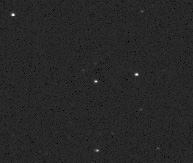
Some Asteroids cross the path of Earth and the other inner planets (NEOs). They are all rather small but large enough to pose
major danger if one was to strike Earth. Not planets, nor planetoids, they are just chunks of space junk... but
then again, they are full of valuable material that businesses on Earth can use. Someday soon...

|
MARS |
1.5 |
Sol 4 |
maroonish rock and ice |
sphere |
great |
The place most like the Earth, it has a pink atmosphere, red rocky landscape and polar ice caps that used to be an ocean of water.

|
Phobos |
1.5 |
Mars 1 |
grey rock |
irregular |
ok |
Both of Mars' moons were originally asteroids. They were caught by Mars' gravity early on and became moons.
Phobos was almost destroyed once and has the massive scar to prove it.
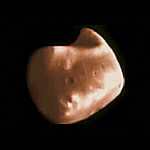
|
Deimos |
1.5 |
Mars 2 |
grey rock and dust |
irregular |
ok |
If people ever landed on Mars' smaller moon, they would have to bring a large broom.
It is smooth like a beach, from the fine particles of destroyed material that something that hit it turned into.
|
Ceres |
2.7 |
asteroid |
grey rock |
sphere |
ok |
Ceres is the closest planetoid to us (dwarf planet), it is located in the Asteroid Belt. It is round like a real planet, and orbits the
Sun with the rest of the astroids (shaped like jagged potatoes). Maybe we should rename it Krypton.

|
Vesta |
2.7 |
asteroid |
grey rock |
spheroid |
ok |
Vesta is the 2rd largest object in the Asteroid Belt after Ceres, and is very interesting because in 2010 NASA's probe DAWN, launched before Bush
cut funding for science missions, will be entering into orbit around it. Finally we will get full details and clear up the debate on how many
valuable minerals are contained in the asteroids. As well, since these asteroids are virtually unchanged since the beginning
of the Solar System, they contain many clues about what things were like before life on Earth.
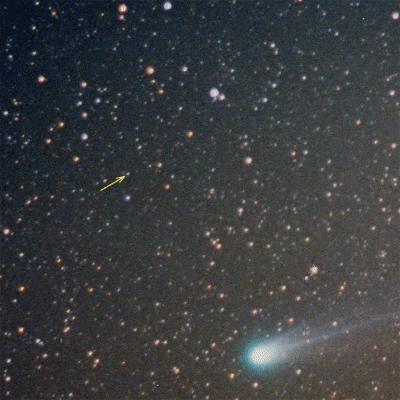
|
Pallas |
2.7 |
asteroid |
grey rock |
spheroid |
ok |
The 3rd significant object in the Asteroid Belt is Pallas, which is also 3rd largest in mass after Ceres and Vesta. NASA's DAWN Asteroid Belt probe
that will study Ceres and Vesta will also go to Pallas, if only its condition is good and it has the energy to do it. Here we see a comet, Hyakutake,
moving through the sky- but look closer and see an arrow pointing at a tiny dot, which is Pallas moving through the Asteroid Belt.

|
JUPITER |
5.2 |
Sol 5 |
gas / molten metallic liquid |
sphere |
no base |
This gas giant is the largest planet and has a molten liquid layer and a solid rock core.
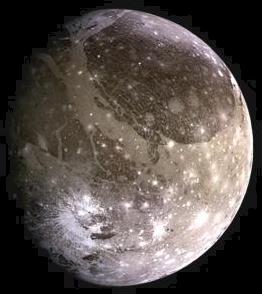
|
Ganymede |
5.2 |
Jupiter 1 |
dark green and brown rock |
sphere |
good |
A moon of ridges and craters in the Jupiter system- this is the largest moon in the Solar System. It has no atmosphere but
a magnetosphere like Earth, because it is active underground, like Earth, but without volcanoes.
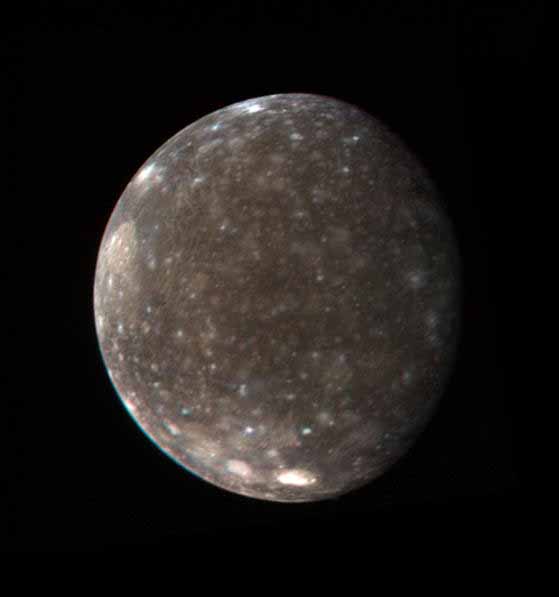
|
Callisto |
5.2 |
Jupiter 2 |
dark green and brown rock |
sphere |
good |
A rocky moon in the Jupiter system, very far orbit, no atmosphere. Its far orbit makes it the best place for
a base in the Jupiter system, since it is not touched by planet's radiation field

|
Io |
5.2 |
Jupiter 3 |
red lava and volcanoes |
sphere |
bad |
A volcanic, molten moon of Jupiter, spewing fountains of lava into space, which fall back onto the surface in great plumes.

|
Europa |
5.2 |
Jupiter 4 |
waterworld with ice cover |
sphere |
great (undersea) |
A moon of solid ice in the Jupiter system with a warm ocean under the ice. No atmosphere. The same comets that
brought the ocean water to Earth- brought water to Mars and Europa through impacting them. In this way, swimming in
H2O in those places is the same as swimming in the oceans of Earth.
|
Amalthea |
5.2 |
Jupiter 5 |
red rock and dust |
irregular |
bad |
This 5th largest moon of Jupiter is only 1/15 the size of the 4th. It is the reddest object in the solar system,
geologically active red rock mixes with refuse from Io's volcanoes as more red coating.

|
SATURN |
9.5 |
Sol 6 |
gas / molten metallic liquid |
sphere |
no base |
A gas giant with a beautiful ring of iceballs and rock. Like Jupiter, below the gas is liquid and solid rock at the core.

|
Titan |
9.5 |
Saturn 1 |
oceans and orangish rock |
sphere |
great |
The Saturn system's largest moon has oceans, land and an orange atmosphere.
Building blocks of life are here like they were on the early Earth.
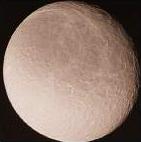
|
Rhea |
9.5 |
Saturn 2 |
greyish ice and rock |
sphere |
ok |
An ice moon with small amounts of rock, Rhea is Saturn's 2nd largest moon.
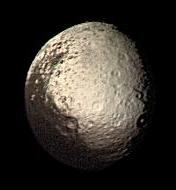
|
Iapetus |
9.5 |
Saturn 3 |
light grey one side, dark other |
sphere |
ok |
This moon of Saturn is bizarre because one side is dark like Neptune's Proteus and the other side is bright like Europa.
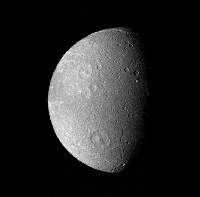
|
Dione |
9.5 |
Saturn 4 |
greyish ice and rock |
sphere |
ok |
Satern's moon like its neighbor Rhea. An ice moon with some streaks left over from early geologic ice volcanoes.
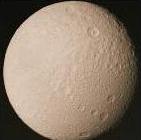
|
Tethys |
9.5 |
Saturn 5 |
greyish ice and rock |
sphere |
ok |
Another Saturnian ice moon with some rock. Same density as water, but this one has a massive crater that almost destroyed it.
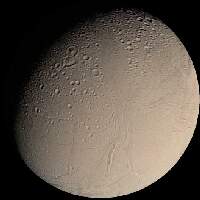
|
Enceladus |
9.5 |
Saturn 6 |
bright white rock and ice |
sphere |
bad |
This moon of Saturn is the brightest object in the Solar System except the sun because it is very white with an icy
and rocky exterior. The interior is active, probably with a kind of ice volcano like on Triton.
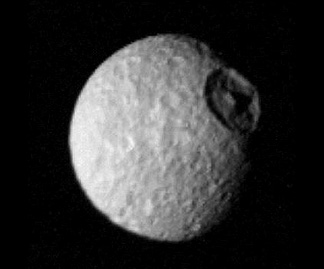
|
Mimas |
9.5 |
Saturn 7 |
grey ice and rock |
spheroid |
ok |
This rock moon of Saturn was almost destroyed armaggedon style but barely survived.
Now it has a 90 mile gorge in it that makes the whole moon look like the Death Star from Star Wars.
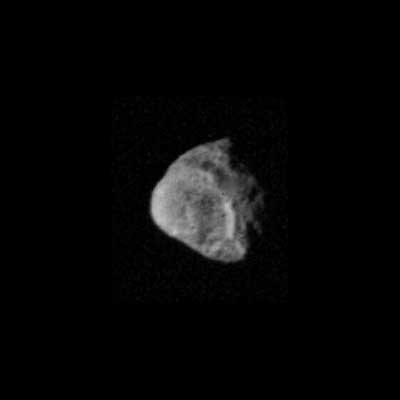
|
Hyperion |
9.5 |
Saturn 8 |
dark grey rock and ice |
irregular |
ok |
A weird orbiting irregular moon of Saturn, strangest but for Nereid, it weaves too and fro as it travels around the planet.
NASA thinks it may have been the remnant of a moon that was obliterated to help form the rings.

|
URANUS |
19.6 |
Sol 7 |
gas / methane ice |
sphere |
no base |
This ice giant has a gas atmosphere and liquid methane interior, tilted sideways from an early collision.
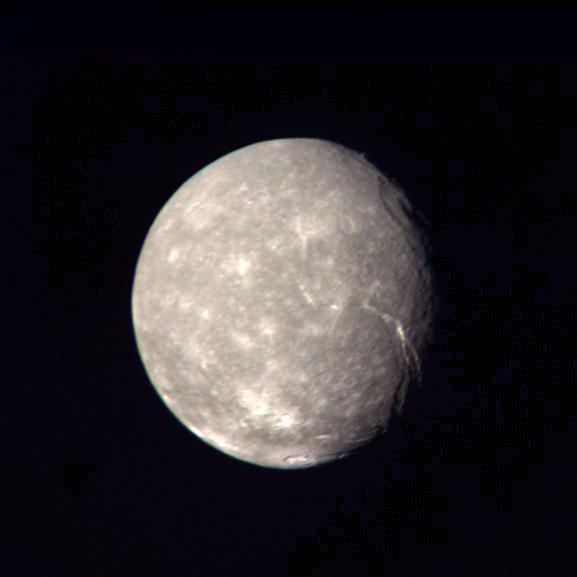
|
Titania |
19.6 |
Uranus 1 |
greyish rock and ice |
sphere |
ok |
Largest moon of the Uranus system is strange because it has hardly any craters because it used to have liquid water
and internal heat, when the heat went away the water froze, smoothing it. It is half ice and half rock.
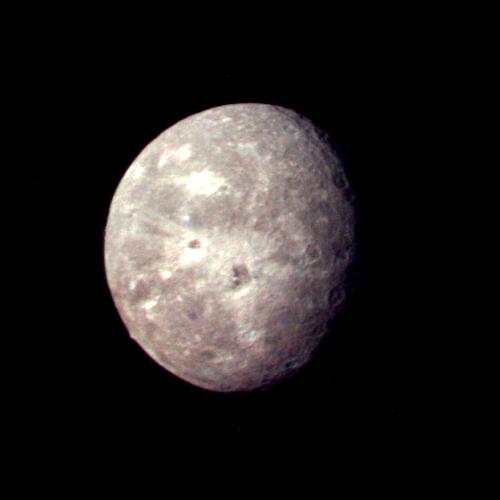
|
Oberon |
19.6 |
Uranus 2 |
greyish rock and ice |
sphere |
ok |
Another moon of Uranus, Oberon is half ice and half rock with many craters, and a 4 mile high mountain.
Geologic activity ended earlier here, so there are more craters than on the other moons.
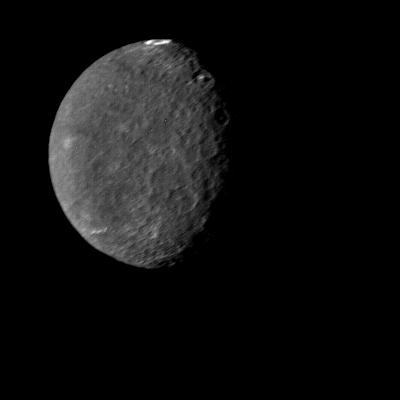
|
Umbriel |
19.6 |
Uranus 3 |
dark greyish rock and ice |
sphere |
ok |
This Uranus moon's surface is dark and only reflects 10% of the light that it recieves from Uranus and the Sun.
Why is unknown. Geological activity ended earlier here than the other moons, meaning more craters.

|
Ariel |
19.6 |
Uranus 4 |
light greyish rock and ice |
sphere |
ok |
Another Uranus moon that used to be active but is not anymore.
Has some areas where craters are still filled in. It is Uranus's brightest moon.

|
Miranda |
19.6 |
Uranus 5 |
dark grey rock and ice |
sphere |
ok |
This formerly geologically active moon of Uranus has the most bizarre topography because early on an asteroid smashed into it,
destroyed it and yet it reassembled. So its surface isn't all craters or all ice or all ridges or all anything, it is all mixed up.

|
NEPTUNE |
30 |
Sol 8 |
gas / methane ice |
sphere |
no base |
An ice giant that also has a gas atmosphere and liquid methane interior

|
Triton |
30 |
Neptune 1 |
white rock and ice volcanoes |
sphere |
ok |
This moon in the Neptune system is rock and ice, spewing guysers of water out of it.
Orbits backward cause it was caught in Neptune's gravity.
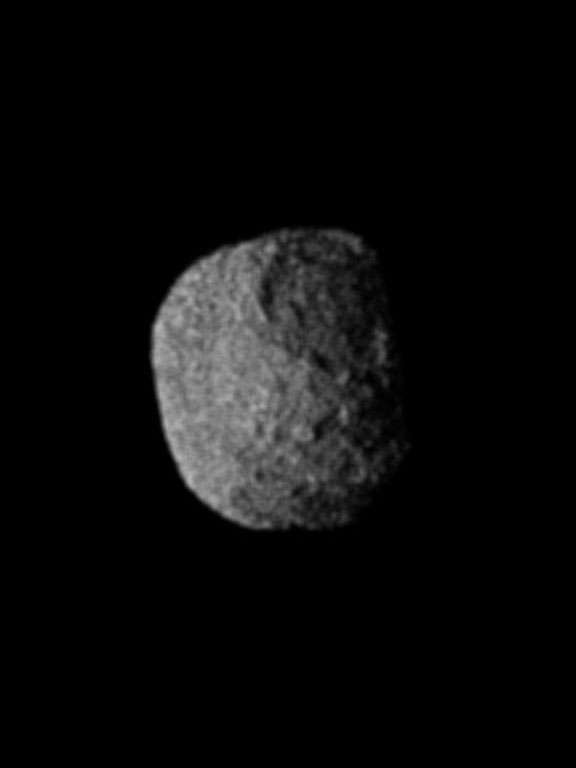
|
Proteus |
30 |
Neptune 2 |
dark grey rock |
spheroid |
ok |
The darkest moon in the solar system, Proteus' surface gives off 6% of the light it gets (not much) from Neptune and the Sun.
It has been beaten senseless by small wandering objects and has many craters.
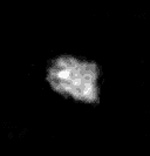
|
Nereid |
30 |
Neptune 3 |
dark grey rock |
irregular |
ok |
A potato moon around Neptune, it has the most erratic orbit of anything in the solar system.
Sometimes it is 700,000 miles from Neptune, sometimes 3,000,000.

|
PLUTO |
39 |
Sol 9 |
purplish rock with ice crystals |
sphere |
ok |
A purplish rocky world with a thin atmosphere that freezes to form ice crystals on the surface.
No, it may not be a planet, but for 75 years after Clyde Tombaugh discovered it using a blink microscope,
history says it was. Just between you and me then, our Solar System has 9 planets. sssh.
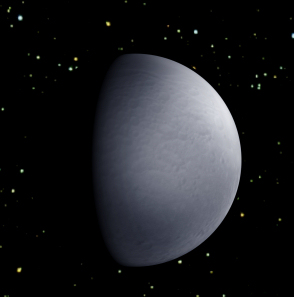
|
Charon |
39 |
Pluto 1 |
dark greyish rock and ice |
sphere |
ok |
Pluto's medium sized moon is a frozen ball of ice and rock and is the largest moon in relation to its planet. It tugs at Pluto and moves
it with its gravity because of this ratio. Like the Moon, Charon keeps the same face towards Pluto all the time (geosynchronous orbit).
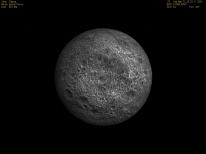
|
Orcus |
40 |
planetoid |
grey rock |
sphere |
ok |
Recently it was discovered that Pluto was not alone amongst the comets in the outermost reaches of the Solar System, but accompanied by many friends.
These objects are planetoids (dwarf planets) that have long and strange orbits. 40 AU is the average distance for Orcus,
but like all the other new far-out objects, is a lot closer at its closest and farther at its furthest.
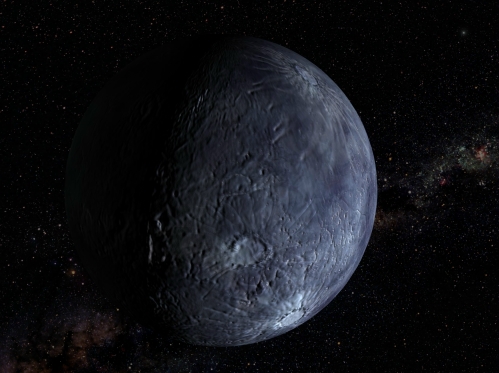
|
Quaoar |
43 |
planetoid |
grey blue rock |
sphere |
ok |
Quaoar was discovered in 2002, and it was realized at that point that all these far out obects were part of a 2nd Asteroid Belt,
called the Kuiper Belt, that is much less dense than the closer Asteroid Belt, but much bigger. It is the place comets come from.
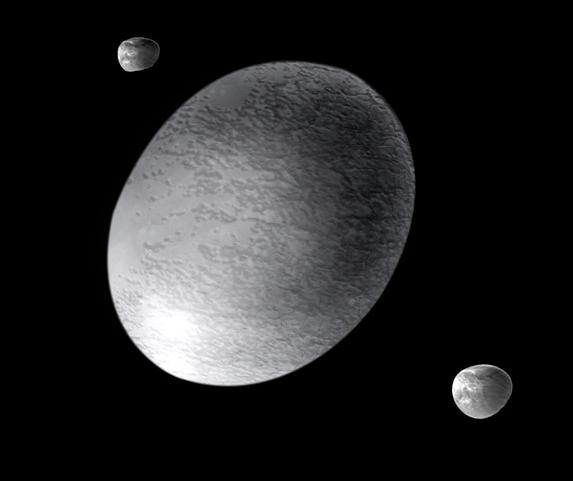
|
2003 EL 61 |
44 |
planetoid |
grey rock |
spheroid |
ok |
This planetoid had no real name yet, just "2003 EL61." It was found around Christmastime in that year, and astronomers nicknamed it 'Santa'
- but the mean International Astronomical Union said "no, the rule is that any new object found has to be named after a 'creation myth deity.'
Santa, who creates preasants and happiness for children around the world, is unacceptable."
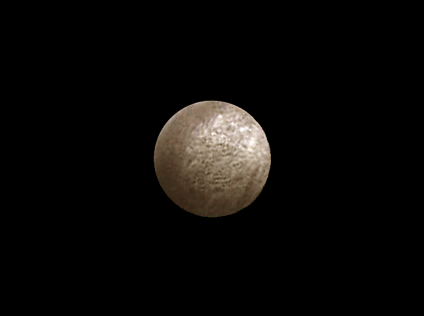
|
Varuna |
45 |
planetoid |
grey rock |
sphere |
ok |
When Pluto was discovered by Clyde Tombaugh in 1930 using a blink microscope, he could narrow down where to look because
of the minute gravitational tug that Pluto exerts on Neptune- altering its orbit ever so slightly. After Pluto, people wondered about a
10th planet, 'Planet X'. But nothing was ever discovered, until in the year 2000, astronomers found Varuna. Much smaller than Pluto,
(see list at top of page), it is, however, the first of the new class of planetoids to be found.
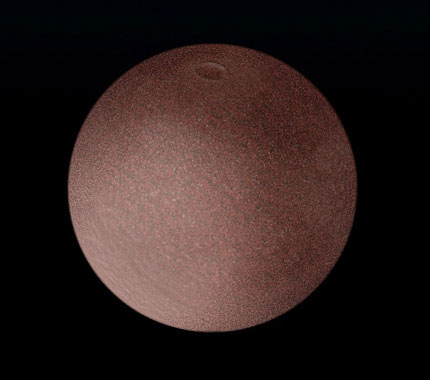
|
2005 FY9 |
43 |
planetoid |
dark red rock |
sphere |
ok |
This planetoid had no real name yet, just "2005 FY 9." It was found around Easter in that year, and astronomers nicknamed it 'Easter Bunny'
- but the mean International Astronomical Union said "no, the rule is that any new object found has to be named after a 'creation myth deity.'
The Easter Bunny, who brings boys and girls little treats on the day of Christ's Resurrection from the dead, is unacceptable."
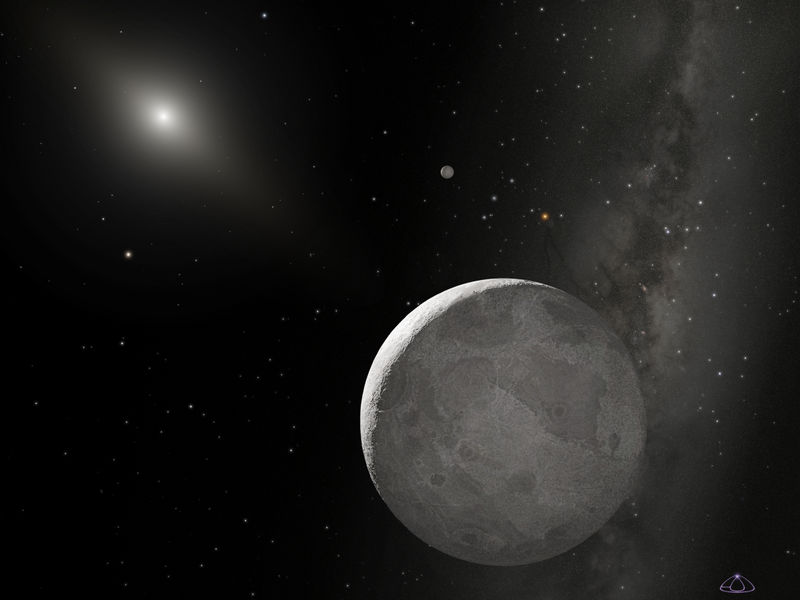
|
Eris |
68 |
planetoid |
grey rock |
sphere |
ok |
Eris was discovered in 2003- soldifying the idea that the Kuiper Belt is a place of many significant worlds. Why was it Eris that did this? Because
this planetoid is larger than Pluto itself! What wonderful worlds await us in the future, as humankind travels all around our Solar Neighborhood,
placing colony here, mining asteroid there, terriforming this place, mapping and charting that region.
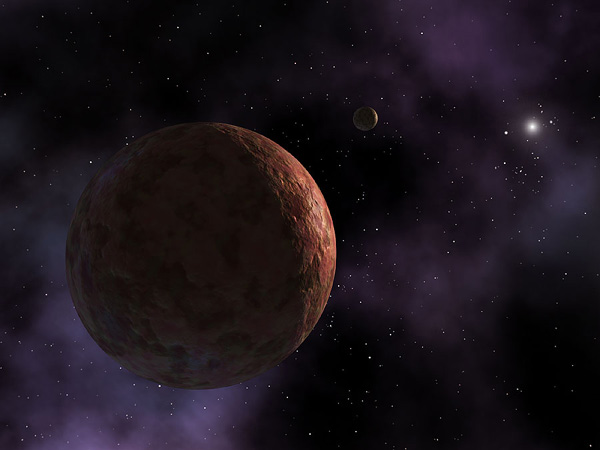
|
Sedna |
525 |
planetoid |
maroon rock |
sphere |
ok |
Sedna was discovered in 2003 and immediately, when its orbit was figured, caused a stir. Is it really so far out? Eris, the 2nd furthest object,
is 68 AU. Sedna meanwhile, is an incredible 525 AU. That means when Sedna at its furthest is over 500 times farther from the
Sun than Earth. In fact, it takes 12,000 years to go around the Sun! Is it alone? We will find out in the years to come.
Check out the original 1957 launch of Sputnik here
To fully take advantage of living in Hudson, its good to know a little about the night sky. Our special combination of mild winters, clear skies and bright stars (because of the conspicuous lack of light pollution at night) make it a prime place (like Cape Canaveral exactly opposite us on the East Coast) for starviewing. And besides, what will the high school geography class of 2100 be studying? Perhaps even by then, we may be on our way to being a multi-planet species. It is absolutely inevitable for people to eventually explore and colonize our solar neighborhood. In what an amazing age we will live, on that day when we reach out to the rest of our star system.
Should you be inspired by this site to watch movies about space and space travel, find here a complete list of all of them!
New******See just the planets and moons in their original positions!******New
New******Why it all Matters: Space and Survival******New
|
Solar X-rays: |
|
|
From n3kl.org